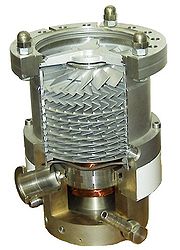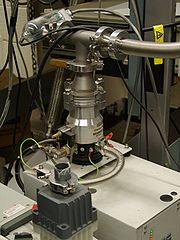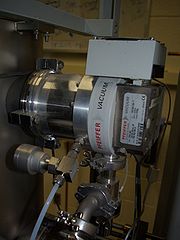
Turbomolecular pump
Encyclopedia

Vacuum pump
A vacuum pump is a device that removes gas molecules from a sealed volume in order to leave behind a partial vacuum. The first vacuum pump was invented in 1650 by Otto von Guericke.- Types :Pumps can be broadly categorized according to three techniques:...
, superficially similar to a turbopump
Turbopump
A turbopump is a gas turbine that comprises basically two main components: a rotodynamic pump and a driving turbine, usually both mounted on the same shaft, or sometimes geared together...
, used to obtain and maintain high vacuum
Vacuum
In everyday usage, vacuum is a volume of space that is essentially empty of matter, such that its gaseous pressure is much less than atmospheric pressure. The word comes from the Latin term for "empty". A perfect vacuum would be one with no particles in it at all, which is impossible to achieve in...
. These pumps work on the principle that gas molecules can be given momentum
Momentum
In classical mechanics, linear momentum or translational momentum is the product of the mass and velocity of an object...
in a desired direction by repeated collision with a moving solid surface. In a turbomolecular pump, a rapidly spinning turbine
Turbine
A turbine is a rotary engine that extracts energy from a fluid flow and converts it into useful work.The simplest turbines have one moving part, a rotor assembly, which is a shaft or drum with blades attached. Moving fluid acts on the blades, or the blades react to the flow, so that they move and...
rotor 'hits' gas molecules from the inlet of the pump
Pump
A pump is a device used to move fluids, such as liquids, gases or slurries.A pump displaces a volume by physical or mechanical action. Pumps fall into three major groups: direct lift, displacement, and gravity pumps...
towards the exhaust in order to create or maintain a vacuum
Vacuum
In everyday usage, vacuum is a volume of space that is essentially empty of matter, such that its gaseous pressure is much less than atmospheric pressure. The word comes from the Latin term for "empty". A perfect vacuum would be one with no particles in it at all, which is impossible to achieve in...
.
Operating principles
Most turbomolecular pumps employ multiple stages consisting of rotor/statorStator
The stator is the stationary part of a rotor system, found in an electric generator, electric motor and biological rotors.Depending on the configuration of a spinning electromotive device the stator may act as the field magnet, interacting with the armature to create motion, or it may act as the...
pairs mounted in series. Gas captured by the upper stages is pushed into the lower stages and successively compressed to the level of the fore-vacuum (backing pump) pressure.
As the gas molecules enter through the inlet, the rotor, which has a number of angled blades, hits the molecules. Thus the mechanical energy of the blades is transferred to the gas molecules. With this newly acquired momentum, the gas molecules enter into the gas transfer holes in the stator. This leads them to the next stage where they again collide with the rotor surface, and this process is continued, finally leading them outwards through the exhaust.
Because of the relative motion of rotor and stator, molecules preferably hit the lower side of the blades. Because the blade surface looks down, most of the scattered molecules will leave it downwards. The surface is rough, so no reflection will occur. A blade needs to be thick and stable for high pressure operation and as thin as possible and slightly bent for maximum compression. For high compression ratios the throat between adjacent rotor blades (as shown in the image) is pointing as much as possible in the forward direction. For high flow rates the blades are at 45° and reach close to the axis.
Because the compression of each stage is ~10, each stage closer to the outlet is considerably smaller than the preceding inlet stages. This has two consequences. The geometric progression
Geometric progression
In mathematics, a geometric progression, also known as a geometric sequence, is a sequence of numbers where each term after the first is found by multiplying the previous one by a fixed non-zero number called the common ratio. For example, the sequence 2, 6, 18, 54, ... is a geometric progression...
tells us that infinite stages could ideally fit into a finite axial length. The finite length in this case is the full height of the housing as the bearings
Bearing (mechanical)
A bearing is a device to allow constrained relative motion between two or more parts, typically rotation or linear movement. Bearings may be classified broadly according to the motions they allow and according to their principle of operation as well as by the directions of applied loads they can...
, the motor, and controller and some of the coolers can be installed inside on the axis. Radially, to grasp as much of the thin gas at the entrance, the inlet-side rotors would ideally have a larger radius, and correspondingly higher centrifugal force
Centrifugal force
Centrifugal force can generally be any force directed outward relative to some origin. More particularly, in classical mechanics, the centrifugal force is an outward force which arises when describing the motion of objects in a rotating reference frame...
; ideal blades would get exponentially thinner towards their tips and carbon fibers should reinforce the aluminium blades. However, because the average speed of a blade affects pumping so much this is done by increasing the root diameter rather than the tip diameter where practical.
Turbomolecular pumps must operate at very high speeds, and the friction heat buildup imposes design limitations. Some turbomolecular pumps use magnetic bearing
Magnetic bearing
A magnetic bearing is a bearing which supports a load using magnetic levitation. Magnetic bearings support moving machinery without physical contact; for example, they can levitate a rotating shaft and permit relative motion with very low friction and no mechanical wear...
s to reduce friction and oil contamination. Because the magnetic bearing
Magnetic bearing
A magnetic bearing is a bearing which supports a load using magnetic levitation. Magnetic bearings support moving machinery without physical contact; for example, they can levitate a rotating shaft and permit relative motion with very low friction and no mechanical wear...
s and the temperature cycles allow for only a limited clearance between rotor and stator, the blades at the high pressure stages are somewhat degenerated into a single helical foil each. Laminar flow
Laminar flow
Laminar flow, sometimes known as streamline flow, occurs when a fluid flows in parallel layers, with no disruption between the layers. At low velocities the fluid tends to flow without lateral mixing, and adjacent layers slide past one another like playing cards. There are no cross currents...
cannot be used for pumping, because laminar turbines stall when not used at the designed flow. The pump can be cooled down to improve the compression, but should not be so cold as to condense ice on the blades.
When a turbopump is stopped, the oil from the backing vacuum may backstream through the turbopump and contaminate the chamber. One way to prevent this is to introduce a laminar flow of nitrogen through the pump. The transition from vacuum to nitrogen and from a running to a still turbopump has to be synchronized precisely to avoid mechanical stress to the pump and overpressure at the exhaust. A thin membrane and a valve at the exhaust should be added to protect the turbopump from excessive back pressure (e.g. after a power failure or leaks in the backing vacuum).
The rotor is stabilized in all of its six degrees of freedom
Degrees of freedom (engineering)
In mechanics, degrees of freedom are the set of independent displacements and/or rotations that specify completely the displaced or deformed position and orientation of the body or system...
. One degree is governed by the electric motor
Electric motor
An electric motor converts electrical energy into mechanical energy.Most electric motors operate through the interaction of magnetic fields and current-carrying conductors to generate force...
. Minimally, this degree must be stabilized electronically (or by a diamagnetic material, which is too unstable to be used in a precision pump bearing). Another way (ignoring losses in magnetic cores at high frequencies) is to construct this bearing as an axis with a sphere at each end. These spheres are inside hollow static spheres. On the surface of each sphere is a checkerboard pattern of inwards and outwards going magnetic field lines. As the checkerboard pattern of the static spheres is rotated, the rotor rotates. In this construction no axis is made stable on the cost of making another axis unstable, but all axes are neutral and the electronic regulation is less stressed and will be more dynamically stable. Hall effect sensor
Hall effect sensor
A Hall effect sensor is a transducer that varies its output voltage in response to a magnetic field. Hall effect sensors are used for proximity switching, positioning, speed detection, and current sensing applications....
s can be used to sense the rotational position and the other degrees of freedom can be measured capacitively.
Maximum pressure

Mean free path
In physics, the mean free path is the average distance covered by a moving particle between successive impacts which modify its direction or energy or other particle properties.-Derivation:...
of air is about 70 nm. Turbomolecular blades cannot be built with anything close to such a small clearance, so this type of pump stalls if exhausted directly to the atmosphere. Nonetheless Varian, Inc.
Varian, Inc.
Varian, Inc. was one of the largest manufacturers of scientific instruments for the scientific industry; they had offerings over the whole range of chemical analysis equipment, with a particular focus on Information Rich Detection and Vacuum technology...
since 2006 offers a pump where the last stages have blades optimized for zero flow and can pump against a pressure of one atmosphere. Because the low pressure stages are limiting the flow, the high pressure stages can be fixed to zero flow. Theoretically centrifugal pump
Centrifugal pump
A centrifugal pump is a rotodynamic pump that uses a rotating impeller to create flow by the addition of energy to a fluid. Centrifugal pumps are commonly used to move liquids through piping...
s could be used, but it is more compact to use a circulating flow between hollow threads in the rotor and the stator. In other cases the exhaust is connected to a backing pump, which produces a pressure low enough for the turbomolecular pump to work efficiently. Typically, this pressure must be below 10 Pa with 1-2 Pa as common averages.
The turbomolecular pump can be a very versatile pump. It can generate many degrees of vacuum from intermediate vacuum (~10−2 Pa) up to ultra-high vacuum
Ultra high vacuum
Ultra-high vacuum is the vacuum regime characterised by pressures lower than about 10−7 pascal or 100 nanopascals . UHV requires the use of unusual materials in construction and by heating the entire system to 180°C for several hours to remove water and other trace gases which adsorb on the...
levels (~10−8 Pa).
Multiple turbomolecular pumps in a lab or manufacturing-plant can be connected by tubes to a small backing pump. Automatic valves and diffusion pump
Diffusion pump
Diffusion pumps use a high speed jet of vapor to direct gas molecules in the pump throat down into the bottom of the pump and out the exhaust. Presented in 1915 by Wolfgang Gaede and using mercury vapor, they were the first type of high vacuum pumps operating in the regime of free molecular flow,...
like injection into a large buffer-tube in front of the backing pump prevents any overpressure from one pump to stall another pump.
Practical considerations

Fluid dynamics
In physics, fluid dynamics is a sub-discipline of fluid mechanics that deals with fluid flow—the natural science of fluids in motion. It has several subdisciplines itself, including aerodynamics and hydrodynamics...
do not apply in high vacuum
Vacuum
In everyday usage, vacuum is a volume of space that is essentially empty of matter, such that its gaseous pressure is much less than atmospheric pressure. The word comes from the Latin term for "empty". A perfect vacuum would be one with no particles in it at all, which is impossible to achieve in...
environments. The maximum compression varies linearly with circumferential rotor speed. In order to obtain extremely low pressure
Pressure
Pressure is the force per unit area applied in a direction perpendicular to the surface of an object. Gauge pressure is the pressure relative to the local atmospheric or ambient pressure.- Definition :...
s down to 1 micropascal
Pascal (unit)
The pascal is the SI derived unit of pressure, internal pressure, stress, Young's modulus and tensile strength, named after the French mathematician, physicist, inventor, writer, and philosopher Blaise Pascal. It is a measure of force per unit area, defined as one newton per square metre...
, rotation rates of 20,000 to 90,000 revolutions per minute are often necessary. Unfortunately, the compression ratio varies exponentially with the square root of the molecular weight of the gas. Thus, heavy molecules are pumped much more efficiently than light molecules. Most gases are heavy enough to be well pumped but it is difficult to pump hydrogen
Hydrogen
Hydrogen is the chemical element with atomic number 1. It is represented by the symbol H. With an average atomic weight of , hydrogen is the lightest and most abundant chemical element, constituting roughly 75% of the Universe's chemical elemental mass. Stars in the main sequence are mainly...
and helium
Helium
Helium is the chemical element with atomic number 2 and an atomic weight of 4.002602, which is represented by the symbol He. It is a colorless, odorless, tasteless, non-toxic, inert, monatomic gas that heads the noble gas group in the periodic table...
efficiently.
An additional drawback stems from the high rotor speed of this type of pump: very high grade bearing
Bearing (mechanical)
A bearing is a device to allow constrained relative motion between two or more parts, typically rotation or linear movement. Bearings may be classified broadly according to the motions they allow and according to their principle of operation as well as by the directions of applied loads they can...
s are required, which increase the cost.
Because turbomolecular pumps only work in molecular flow conditions, a pure turbomolecular pump will require a very large backing pump to work effectively. Thus, many modern pumps have a molecular drag stage such as a Holweck or Gaede mechanism near the exhaust to reduce the size of backing pump required.

